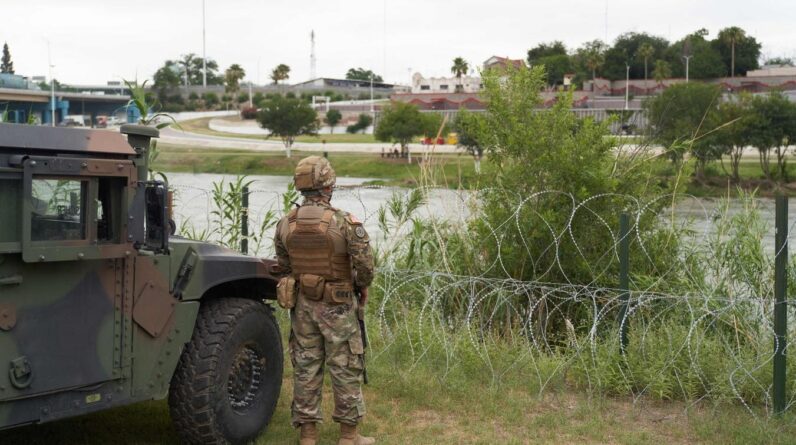
A National Guard soldier stands by as Texas Governor Greg Abbott walks the US-Mexico border in the … [+]
AFP via Getty Images
The history of the Mexican-American War should serve as a cautionary tale for right-wing American politicians who fearmonger about the border and advocate military attacks on Mexico.
The 2,000-mile border between the US and Mexico has become a turning point in US domestic politics. Former President Donald Trump catalyzed his rise to power with a call to build a wall on the US-Mexico border. In 2023, Trump and other mainstream right-wing politicians are actively calling for the US military to invade Mexico and attack Mexico’s drug cartels. A recent survey found that 70% of Republican voters in the US support the idea of deploying the US military to fight organized crime groups in Mexico. Right-wing governors are even sending National Guard troops from faraway states to patrol the border region. But in both the US and Mexico, most political commentators avoid the subject of how the modern borderland was established.
Just 200 years ago, much of the western fringe of today’s borderland was inhabited or visited by small groups of Spanish- or English-speaking settlers and traders. Far from the population centers of central Mexico and the US East Coast, this border region was peripheral and of little importance to the economic and political dynamics of either the US or Mexico.
during a recent podcast discussionhistorian Peter Guardino explained how American politicians should learn from the history of the Mexican-American War, which began in 1846 and ended in 1848.
President James Polk “engineered this war by marching American troops . . . beyond the borders of Texas into . . . territory that almost everyone in the world considered Mexican territory, forcing a confrontation with Mexican forces,” he Guardino said.
In his new book, The March of the Dead: A History of the Mexican-American WarGuardino tells the story of the conflict that killed some 13,000 American soldiers as well as 25,000 Mexicans.
When asked to choose three words to describe the war, Guardino said, “The three words I would think of are tragic, unjust, and harmful. A lot of people died. It was a war of conquest. President Polk and other expansionists wanted California and also New Mexico, [the territory that today is] Arizona, Colorado and Nevada. They were very interested in acquiring this territory”.
In addition to sending troops from Texas to Mexico, the US also launched a second invasion by sea through the port of Veracruz on the Gulf of Mexico.
After bombing civilian neighborhoods in Veracruz and threatening to loot and rape the residents of the city of Puebla, American soldiers marched “towards…Mexico City. That invasion led to many bloody battles [and] ultimately resulted in the occupation of Mexico City,” Guardino said.
American soldiers attacked and seized Chapultepec Castle in Mexico City and even raised the American flag over the Zocolo, the main public square in the historic center.
In addition to fighting regular army units, American soldiers battled strong resistance from mobile guerrilla units. Even after the main battles of the war were over, the soldiers occupying Mexico City also faced constant attacks from civilians.
In his bookGuardino explains that as columns of American soldiers marched into Mexico’s historic center, “more and more [local residents] they gathered and murmured, and as the first American troops approached the central square, a shot wounded an American officer. Others soon followed. A shower of stones rained down from the flat roofs of the city and the crowds turned on the Americans. When the Americans entered the square, the crowd shouted: ‘Death to the Americans’”.
The hostility that the invading American soldiers faced from the residents of Mexico City during the war should serve as a warning to any American politician advocating a new American incursion into Mexico to fight organized crime groups. The history of the war has not been forgotten in Mexico.
“A military intervention in Mexico would be much more difficult than our 20-year effort in Afghanistan. I literally shudder to think of the level of violence. Even military strikes designed to remove the cartel leadership would be a failure.” , Guardino said.
Be it your right-wing governors of distant states sending National Guard troops on the border or Lindsey Graham, Tim Scott or John Kennedy insulting or threatening to invade Mexico, it is important to state clearly that sending US troops to fight drug cartel gunmen in Mexico is not a serious political solution.
The scope of organized crime a the army of Mexicolocal police and export industries such as the sector lawyer has been well documented, so the idea that drug cartels are an easily defined military target is simply a fantasy. Overall, it often seems that the bellicose rhetoric of US Republicans is more an effort to fuel toxic domestic politics in the US than a serious policy proposal to improve security in Mexico.
If there is one lesson to be learned from the Mexican-American War, it is that any attempt to repeat such a brutal military operation would prove an immediate disaster.
Rather than fearmongering about the border, American policymakers should recognize the success story of cross-cultural exchange that the borderland now represents. Today, the US border with Mexico is the most culturally and economically important border in the world. In recent decades, cities such as El Paso and Juarez, Tijuana and San Diego have become major population centers, home to millions of residents and thousands of businesses that benefit from cross-border trade.
In general, U.S. politicians should be celebrating the connections the two countries have built in the border area instead of making foolish calls for military action in Mexico. The story of how the modern frontier was established is important. Advocating for military interventions in Mexico without acknowledging or understanding the history of the Mexican-American War is not only arrogance, it is unforgivable ignorance.
Check out the full conversation with Peter Guardino here.
[ad_2]
Source link





